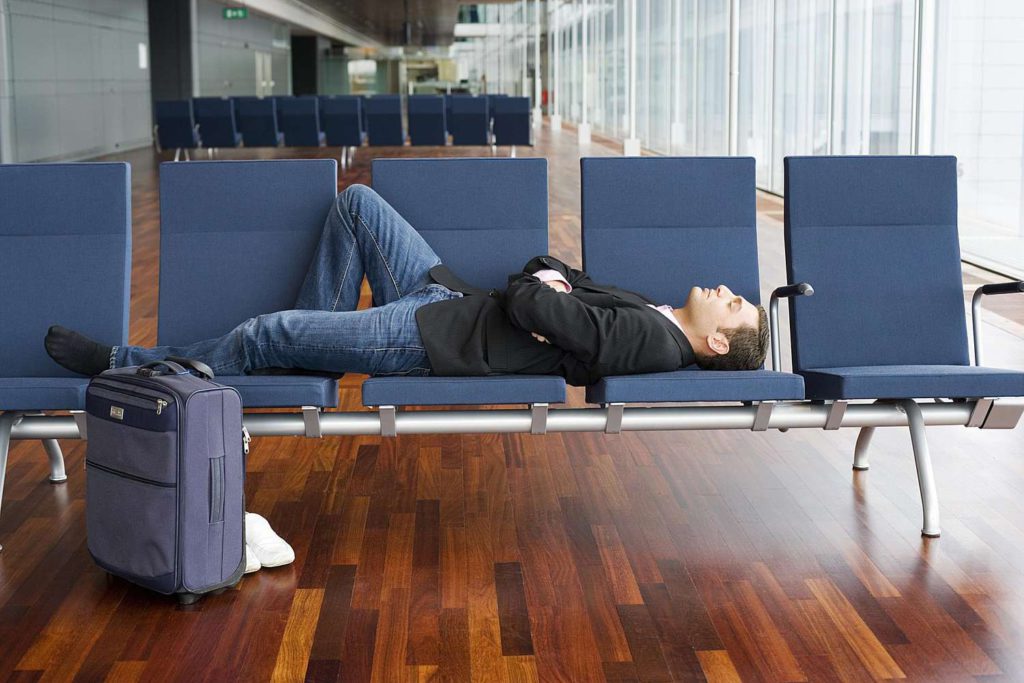Tips
How to Sleep in the Airport (Smartly and Safely in 2025)

Every seasoned traveler has faced it at least once — that long, soul-testing layover where every café chair is occupied, your connecting flight is hours away, and your eyelids feel heavier than your carry-on.
You scan the terminal for a quiet corner, wondering: Can I actually sleep here?
Good news — yes, you can.
In recent times, airport sleeping has gone mainstream. With flight delays, budget travel, and layovers becoming part of modern adventure, many airports now welcome snoozers with sleep pods, quiet zones, and 24-hour lounges. Still, not every airport is equally comfortable, and a few simple tricks can turn a restless night on hard seats into something close to restful sleep.
This guide breaks down everything you need to know: how to prepare, where to find safe spots, what to pack, how to protect yourself, and when to ditch the idea and book a day-use hotel instead.
Why You Might Need to Sleep in an Airport
You probably didn’t plan to. Most of us don’t. But airports have their own rhythm and sometimes you must roll with it. Here are the most common reasons travelers end up sleeping in terminals:
- Long layovers: especially on multi-leg international routes where flights don’t line up neatly.
- Delays or cancellations: weather, strikes, or technical issues can ground you for the night.
- Early-morning departures: instead of paying for a hotel, some travelers camp out to save time and cash.
- Budget or backpack travel: when every dollar matters, airport benches beat pricey city hotels.
- Adventure: yes, some travelers see airport sleeping as a badge of honor — a story to tell.
Modern airports have noticed. Hubs like Singapore Changi, Doha Hamad, and Istanbul Airport now feature sleep capsules, mini-hotels, and recliner zones, while smaller airports provide quiet waiting rooms or 24-hour cafés. Knowing what to expect before you arrive makes all the difference.
Prepare Before You Fly – The Pre-Sleep Checklist
Getting decent rest in an airport starts long before your boarding pass prints. A little preparation can save you hours of discomfort later.
1. Research Your Airport’s Sleep Friendliness
Every airport has a personality. Some welcome overnight sleepers; others politely (or not so politely) kick them out after midnight.
Before your trip:
- Check airport policy on overnight stays via official websites or sleepinginairports.net
- Look for maps showing rest zones, lounges, or 24-hour food courts.
- Read traveler reviews — they reveal hidden gems (like padded benches behind Gate 32).
2. Book or Reserve Ahead
If your layover is long, look into:
- Sleep pods / nap cabins: Available in many hubs; bookable by the hour.
- Airport lounges: Some sell day passes (often with showers and recliners).
- Transit hotels: Connected to terminals, saving visa hassles.
3. Pack an “Airport Sleep Kit”
Even the best lounge won’t help if the lights blaze and announcements echo. Pack these small lifesavers:
| Item | Purpose |
|---|---|
| Eye mask | Blocks harsh lighting |
| Earplugs or noise-canceling earbuds | Drown out boarding calls |
| Travel pillow / neck pillow | Supports your head on chairs |
| Lightweight blanket or scarf | Temperature control |
| Power bank | Keep devices charged overnight |
| Portable lock or cable tie | Secure your bag |
| Reusable water bottle & snacks | Midnight sustenance |
| Disinfectant wipes | Hygiene for benches & hands |
Tip: store these in an easy-reach pouch rather than buried in your main luggage.
4. Dress for Flexibility
Airports swing between polar-cold AC and tropical warmth. Wear breathable layers you can add or peel off. A hoodie doubles as a pillow; a big scarf works as blanket and privacy shield.
5. Mind Your Timing
If you know you’ll spend the night, arrive early to claim a good spot before fellow travelers realize all padded benches are gone. Choose a corner with power outlets, nearby toilets, and low traffic.
“Smart sleepers plan ahead. Check policies, pack comfort gear, dress in layers, and scout your zone before exhaustion hits.“
The Best Spots to Sleep in an Airport
Not every airport bench is created equal. The difference between a tolerable nap and an all-night nightmare often comes down to location. Here’s how to scout the best rest zones.
1. Designated Quiet Zones and Rest Areas
Many modern airports have caught on to the fact that people need rest. Look for “quiet zones,” “rest areas,” or “sleep corners.”
- Singapore Changi (SIN): recliner zones with dim lights, carpets, and charging outlets.
- Doha Hamad (DOH): family quiet rooms with sleeping loungers.
- Helsinki (HEL): offers GoSleep pods with privacy shades.
- Istanbul (IST): nap pods and YOTELAIR mini rooms in-terminal.
These areas are usually marked on the airport map or visible on digital signboards. They’re quieter, safer, and more comfortable than random waiting gates.
2. Airport Lounges – The Paid Comfort Zone
If you can stretch your budget, an airport lounge day pass is often worth every dollar. You get:
- Comfortable recliners or napping chairs
- Hot meals and drinks
- Showers (a life-saver after long flights)
- Power outlets, Wi-Fi, and security
Pro Tip: Even if you’re not flying business class, you can access many lounges via apps like Priority Pass, LoungeBuddy, or DragonPass for around $25–$50.
For long layovers (4+ hours), that’s often cheaper and safer than leaving the airport for a hotel.
3. Sleep Pods and Nap Cabins
A growing number of airports now feature sleep pods, which are private capsules equipped with charging ports, ventilation, and sometimes a small bed or recliner.
Airport Pod Type Price Range Booking Dubai (DXB) Sleep’n Fly Pods $25–$35/hour Walk-in or online Helsinki (HEL) GoSleep Pods $12–$20/hour Online Munich (MUC) NapCabs $15–$18/hour Terminal kiosk Istanbul (IST) YOTELAIR $70–$90 (4 hrs) Pre-book Pods are ideal for solo travelers, especially those who value privacy. However, availability can be limited, so booking in advance is smart.
4. Public Seating and Hidden Corners
For budget travelers or those stuck unexpectedly, public seating remains the classic option. Look for:
- Benches without armrests
- Corners near 24-hour cafés (safer, more light)
- Carpeted corridors behind gates
- Unused gates late at night
Traveler Hack: Find a corner near a power outlet and a CCTV camera — security presence keeps things safer, and you can charge your devices while you rest.
Avoid areas near loudspeaker zones, food courts, and constantly opening automatic doors.
5. Family or Prayer Rooms
If you’re lucky, some airports have family rooms, meditation zones, or prayer areas that remain open and are carpeted — perfect for quiet rest. Be respectful if others are using them for their intended purpose, and use them discreetly.
Safety First: Protecting Yourself and Your Belongings
One major worry for travelers sleeping in public is safety and rightly so. Airports are relatively secure, but it’s still public space. The good news: a few smart precautions go a long way.
1. Choose the Right Spot
Stick to well-lit areas with visible security cameras. Avoid isolated corners, especially in smaller or understaffed terminals.
Sleeping near 24-hour food outlets or other travelers increases safety.2. Keep Your Belongings Close
You don’t want to wake up missing a bag or worse, your passport.
Try these:
- Loop your bag strap around your arm or leg while you sleep.
- Use a small padlock or cable tie on your zippers.
- Keep valuables (passport, phone, wallet) in an inner pocket or neck pouch.
- Use your backpack as a pillow — comfort + protection.
Traveler Tip: Many airports offer baggage wrapping services or lockers; use them if you plan to sleep deeply or explore briefly.
3. Set Multiple Alarms
You’d be surprised how deep exhaustion hits during travel. Set:
- One alarm on your phone
- One vibration alarm on your smartwatch (if available)
- One backup 15–20 minutes earlier
It’s better to wake up early than to miss boarding because your noise-canceling headphones muted everything.
4. Stay Connected
- Join airport Wi-Fi to track flight changes in real time.
- Tell a friend or family member where you are (send a photo or message).
- Keep your phone on low brightness, airplane mode, or battery saver to make it through the night.
5. Know the Rules
While many airports tolerate sleepers, some close terminals overnight or limit access to certain zones.
Security staff may ask for your boarding pass to confirm you’re a passenger. Always stay polite — they’re just doing their job.Quote: “Airport sleep is less about comfort and more about strategy. The safest corner beats the softest couch.”
Comfort Hacks from Frequent Flyers
Sleeping in an airport isn’t just about finding space — it’s about tricking your body into relaxing in a noisy, bright environment.
Here’s what frequent flyers swear by:
1. Light and Noise Control
- Use an eye mask to block overhead lights.
- Earplugs or noise-canceling headphones can mute everything from crying babies to boarding announcements.
- Some travelers play white noise or rain sounds via apps like Calm or Noisli.
2. Temperature Regulation
Airports love cold air-conditioning. Layer up.
If you didn’t pack a blanket, use a scarf or even a large hoodie to trap heat.
Avoid sleeping directly on cold metal chairs — place clothing or a towel beneath you.3. Stretch Before You Sleep
A few light stretches or walks around your gate area improve blood flow and reduce stiffness after you wake up.
4. Power Nap Technique
If you only have 1–2 hours, try the 20-minute nap rule — set your alarm, close your eyes, and don’t fight for deep sleep. You’ll wake refreshed without grogginess.
5. Mind Tricks
Traveling messes with your circadian rhythm. To fall asleep faster:
- Close your eyes and count slow breaths (1–100).
- Picture a calm scene — not your flight delay stress.
- Avoid phone scrolling; it wakes your brain up.
6. Comfortable Positioning
If you can find two or three empty seats, stretch out sideways with your bag under your knees.
If you’re on the floor, use your bag as a headrest and place a jacket or yoga mat beneath you.💡 Pro Tip: Facing a wall gives you psychological safety — fewer people walking past you means more relaxation.
✅ Mini Checklist: Before You Close Your Eyes
- 🧳 Bag looped around your leg
- 📱 Alarm(s) set
- 🕯️ Lights dimmed / mask on
- 🎧 Earplugs in
- 💧 Water within reach
- 🪪 Boarding pass handy
Airport Sleep Comfort, Hygiene & Quality Hacks
Even if you’ve found the perfect spot, comfort in an airport is never guaranteed. Between flickering lights, constant announcements, and fellow travelers pacing at 3 a.m., your “bed” can feel more like a science experiment in endurance.
Here’s how to level up your sleep game and wake up feeling human again.1. Recreate a Sleep Routine (Yes, Even Here)
You might not have a bed, but your brain loves routine. Signal that it’s “time to sleep” with these cues:
- Wash your face or brush your teeth — you’ll feel instantly refreshed.
- Dim your phone brightness or switch to airplane mode.
- Put on your eye mask and earplugs at the same time each night.
- Play white noise or calming sounds through your headphones.
It’s amazing how much faster you’ll fall asleep once your body recognizes these signals.
2. Optimize Lighting and Sound
- Block harsh lights: Use your scarf or hoodie hood as an eye shield if you’ve lost your mask.
- Find quieter corners: Avoid gates used for late-night departures or arrivals.
- Avoid vending machines and cleaners’ stations: These areas stay active even at night.
- Noise tip: White noise apps or a 10-hour “airport ambience” playlist on Spotify can cancel chaos around you.
3. Stay Warm Without Overheating
Airport air conditioning can feel like Antarctica at 2 a.m. Always:
- Keep your feet warm — slip on socks or stuff them in your backpack if you’re cold.
- Lay a jacket or blanket under you to prevent body heat from escaping into the bench.
- If you’re in a humid airport (like Manila or Bangkok), dress light and use your scarf as a sweat towel.
4. Hydration & Nutrition: The Forgotten Essentials
Dehydration and hunger sabotage sleep faster than noise ever could.
- Drink water regularly, but avoid too much caffeine or alcohol.
- Pack light snacks: protein bars, fruit, or nuts keep you energized without bloating.
- Avoid heavy meals close to nap time — your digestion will keep you awake.
If the airport has 24-hour restaurants, check menus for soup, porridge, or sandwiches that are easy on your stomach.
5. Protect Your Hygiene & Dignity
Yes, you’re sleeping in public, but that doesn’t mean you should feel (or smell) like it.
Quick hygiene tips:
- Use wet wipes for a quick “traveler’s shower.”
- Carry deodorant & travel toothbrush — you’ll thank yourself at sunrise.
- Seek showers: Many international airports (e.g., Changi, Doha, Dubai) offer free or low-cost shower facilities.
- Change clothes: Pack a spare t-shirt or travel outfit. Nothing beats the morale boost of feeling clean.
✅ Pro Tip:
Always keep your passport, phone, and wallet on your body — ideally in a money belt or under-shirt pouch. Treat them like an extra layer of clothing, not luggage.
Alternatives, Recommended Airports, and Final Tips
Sometimes, sleeping in the airport just isn’t worth it. Maybe your flight’s delayed by 8 hours, but you’re too tired to fight the noise, or maybe you’re at an airport that bans overnight stays altogether.
That’s when knowing your alternatives saves the day.1. Short-Stay Airport Hotels (Day Rooms & Transit Hotels)
Many airports now offer “microstays” — 3 to 12-hour hotel bookings perfect for layovers.
They’re often located inside terminals or just outside arrivals.Examples:
- YotelAir – found in London Gatwick, Amsterdam Schiphol, and Singapore Changi.
- Aerotel – present in Kuala Lumpur, Abu Dhabi, and London Heathrow.
- Sleep n’ Fly – inside Dubai Airport, ideal for overnight layovers.
Prices range from $50–$100, but the comfort and safety can be worth every cent after a red-eye flight.
2. Airport Lounges: Hidden Havens for Rest
You don’t need first-class tickets to use lounges anymore.
Platforms like Priority Pass, LoungeKey, or even credit card perks let you buy access to airport lounges — many open 24 hours with reclining seats, showers, and food.Look for:
- Plaza Premium Lounge (available in 70+ airports)
- Marhaba Lounge (Dubai, Bahrain, Singapore)
- The Club Lounge (U.S. airports)
If you’re stuck in a less comfy terminal, even a 3-hour lounge pass can recharge you before your flight.
3. When It’s Not Safe to Sleep
Sometimes, it’s better to stay awake.
Avoid sleeping when:
- You’re in a small, dimly lit, or poorly secured terminal.
- There are very few passengers or visible staff.
- The airport explicitly forbids overnight stays.
- You feel uneasy — trust your instincts.
If so, grab a coffee, read, or explore late-night shops until morning. Safety always beats saving a few hours of sleep.
4. Best Airports for Sleeping in 2025
According to traveler reviews and updated airport amenities, these are some of the best airports for catching sleep this year:
Rank Airport Country Why It’s Great 1 Singapore Changi (SIN) Singapore Reclining zones, nap pods, and free movie theatres 2 Doha Hamad International (DOH) Qatar Quiet rooms, gym, and spa access 3 Istanbul Airport (IST) Türkiye Sleep pods, 24/7 food, showers 4 Seoul Incheon (ICN) South Korea Relaxation lounges and cultural zones 5 Munich Airport (MUC) Germany Nap cabins and peaceful rest zones 6 Vancouver International (YVR) Canada Clean, quiet, and safe overnight atmosphere 7 Tokyo Haneda (HND) Japan Clean benches, capsule hotel, polite staff 8 Helsinki Vantaa (HEL) Finland Soothing ambiance and cozy seating 9 Dubai International (DXB) UAE “Sleep n’ Fly” pods and multiple lounges 10 Zurich Airport (ZRH) Switzerland Comfortable lounges and great security These airports have embraced the reality that modern travel doesn’t sleep, making them pioneers in passenger comfort.
5. Airports to Avoid Sleeping In
Not every airport is sleep-friendly. Some close at night, restrict access, or have security patrols that discourage overnight stays.
Examples often mentioned by travelers include:
- Paris Beauvais (BVA) – closes at night.
- Los Angeles LAX (older terminals) – noisy and crowded overnight.
- Newark Liberty (EWR) – limited safe spots.
- Bergamo Orio al Serio (BGY) – benches removed after midnight.
If your itinerary includes one of these, plan a backup stay in a nearby hotel or lounge instead.
6. The Etiquette of Airport Sleeping
Sleeping in airports is a shared experience and how you behave matters:
- Keep your area tidy; don’t sprawl across entire benches if others need space.
- Don’t blast music or alarms use headphones.
- If staff ask you to move, cooperate politely.
- Dispose of wrappers or wipes properly before boarding.
Small gestures make the experience better for everyone — including you.
The Psychology of Sleeping in Airports
It might sound dramatic, but sleeping in an airport teaches resilience. You learn to adapt, to find calm amid chaos, and to make do with what’s around you.
For many travelers, it becomes a rite of passage — proof that adventure often starts before you even reach your destination.And once you’ve done it once, the next time feels less intimidating — almost routine.
Conclusion: Sleep Smart, Travel Freely
Sleeping in an airport isn’t glamorous, but with a little preparation, it can be surprisingly manageable — even empowering.
Remember:
- Plan ahead by researching your airport and packing essentials.
- Stay alert for safety and protect your belongings.
- Be respectful to others sharing the same sleepless night.
Airports are more accommodating than ever, with rest zones, sleep pods, and lounges built for weary travelers.
So the next time your itinerary traps you between flights, don’t panic. Find your corner, wrap up in your hoodie, plug in your charger, and drift off — you’ve earned it.




